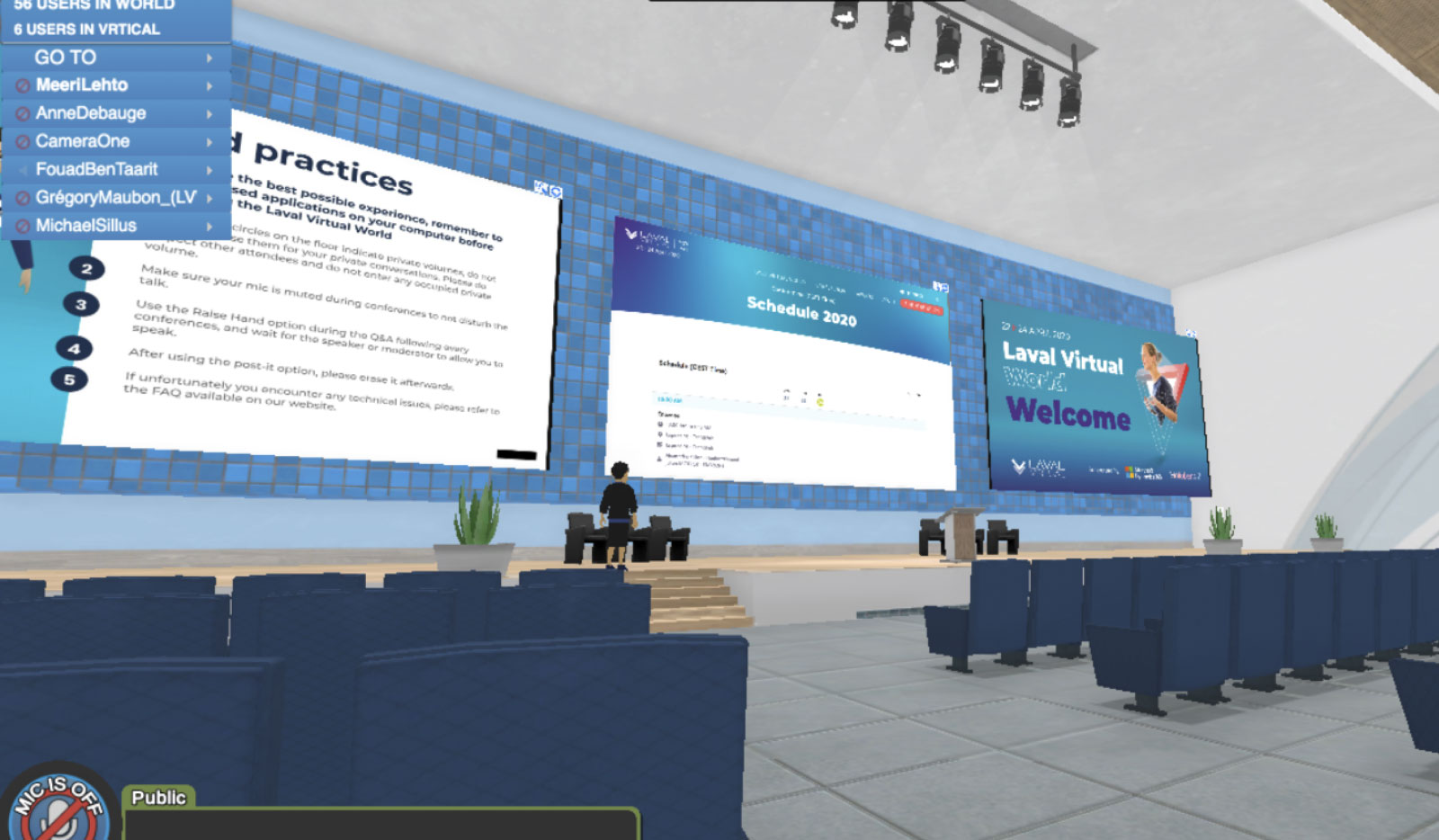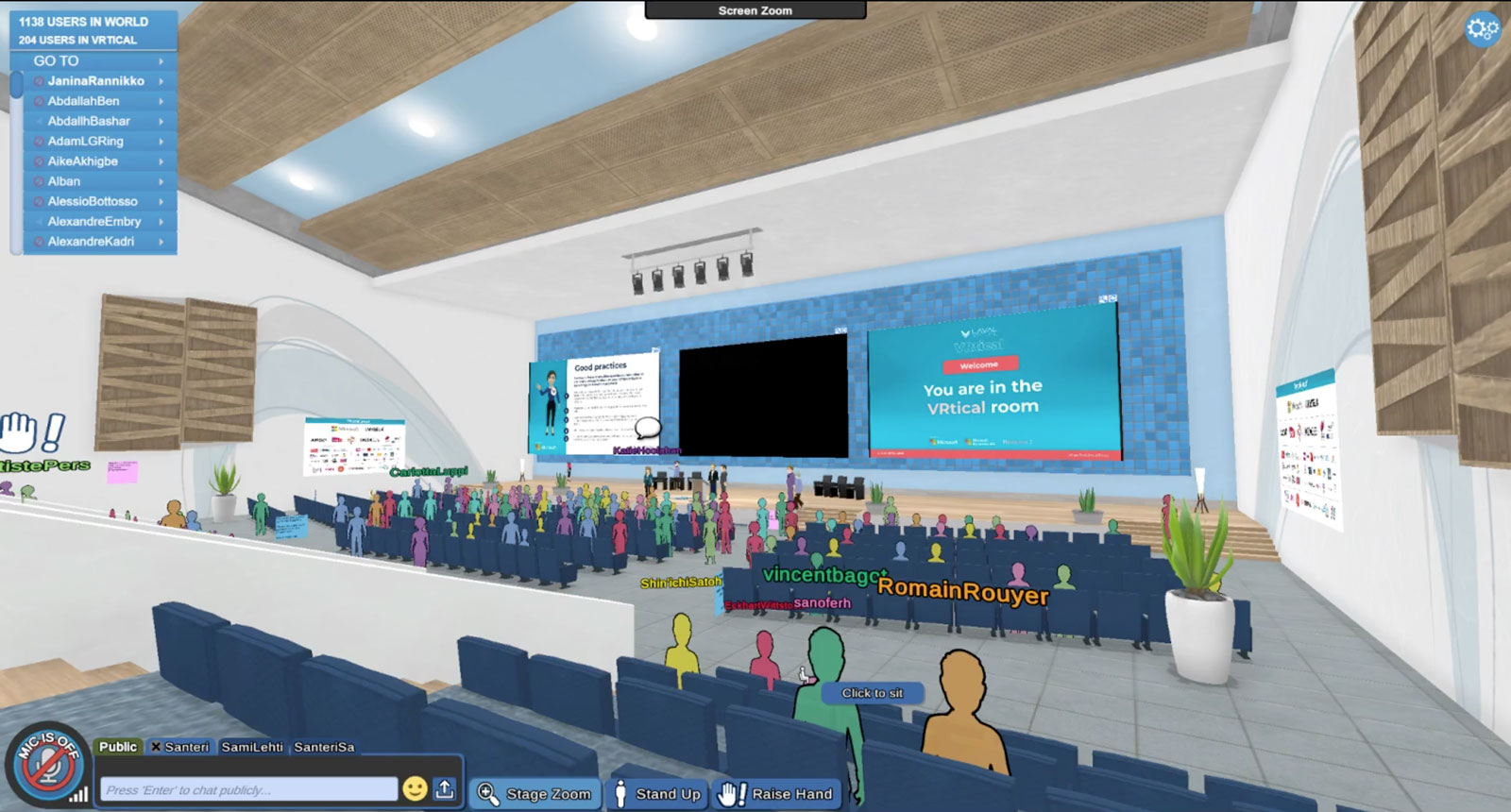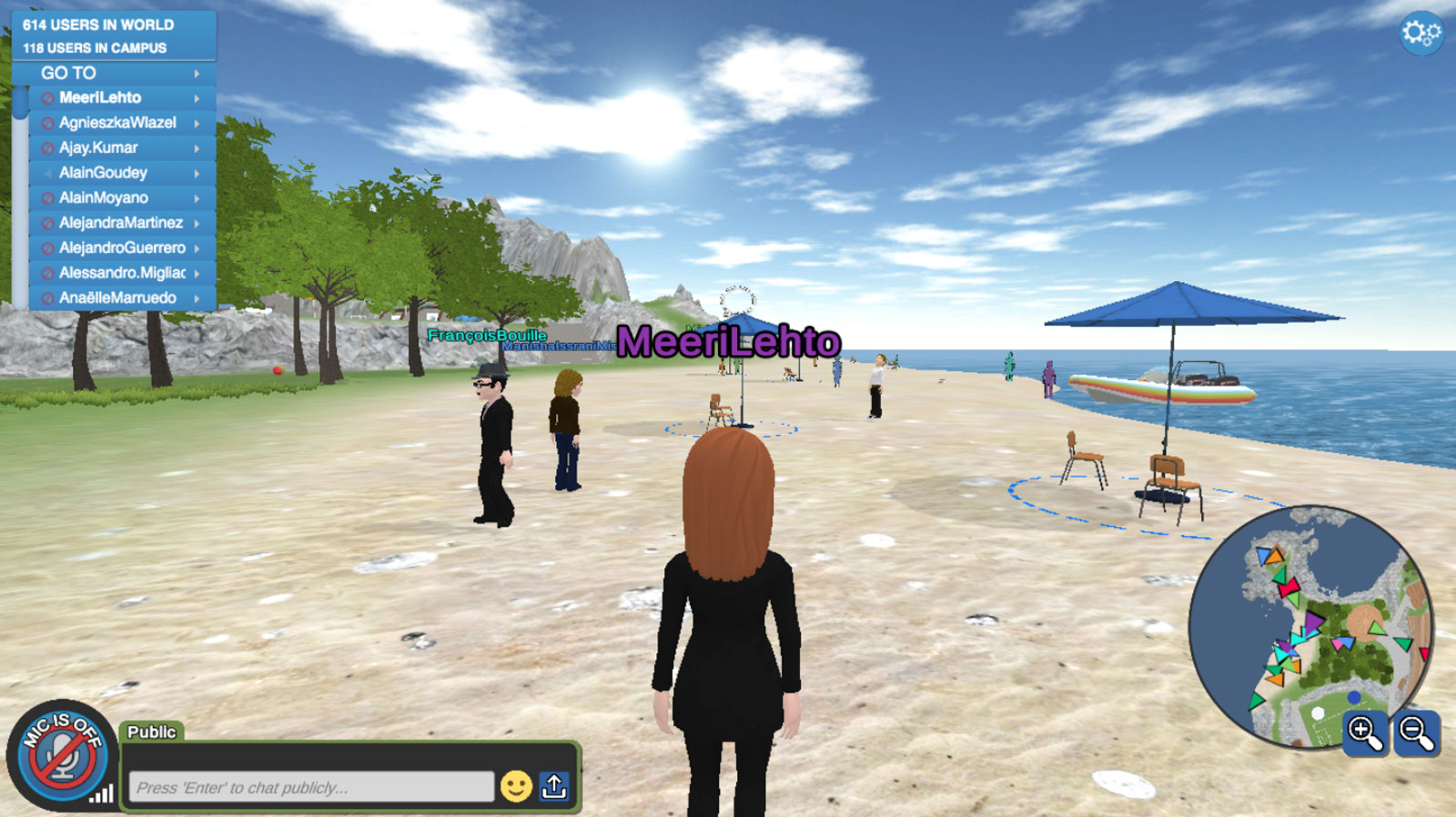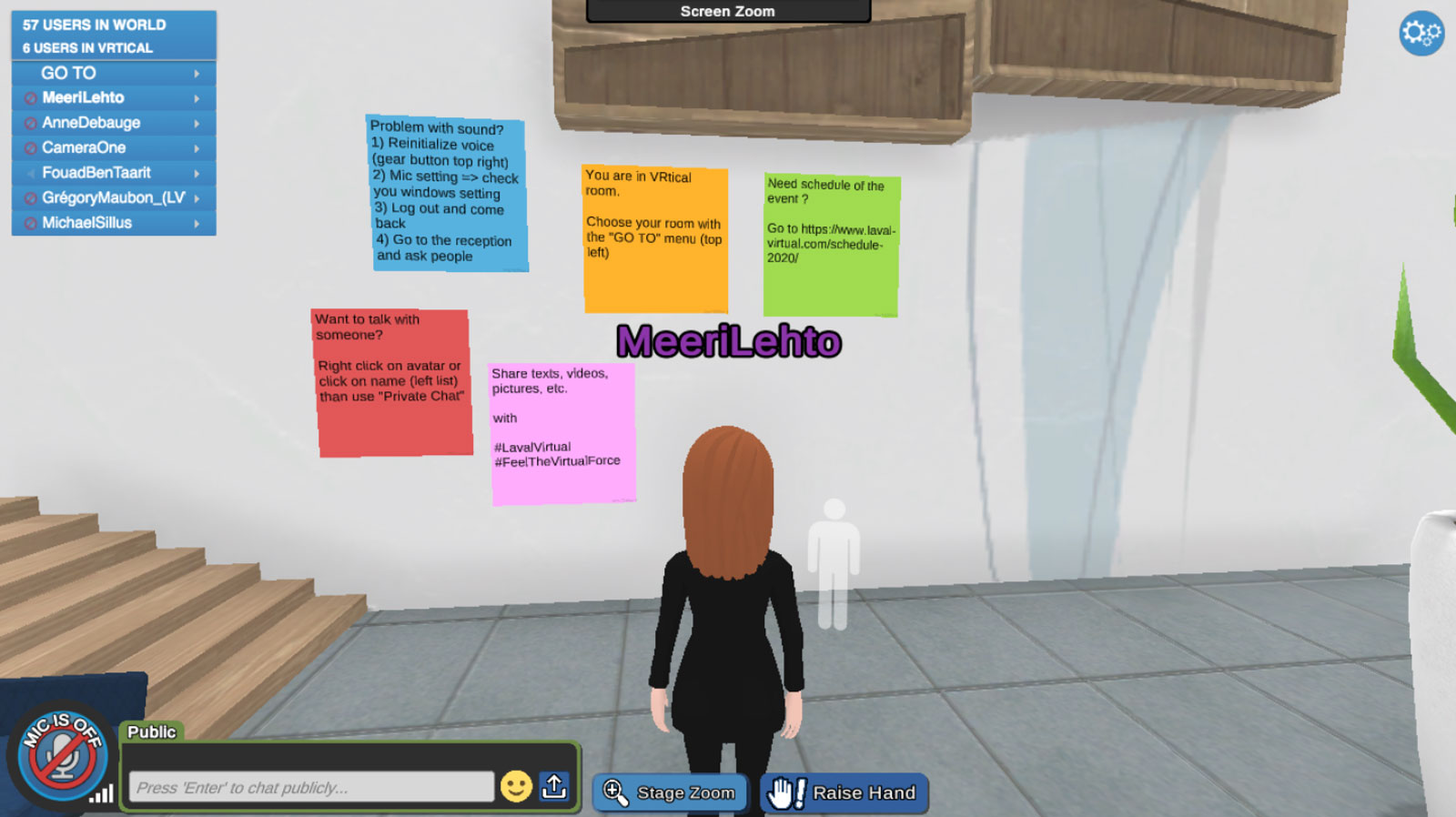We visited a big virtual conference for the first time in the form of Laval Virtual World 2020, and decided to write some thoughts on how it went.

The 22nd Laval Virtual World conference was supposed to be organized at Laval Virtual Center, in Laval, Mayenne, France on 22nd to 26th April 2020. Members of our Helsinki XR Center core team were supposed to travel there and visit the event, but due to the unfortunate event of Coronavirus pandemia, the conference was moved to a virtual environment.
But that didn’t stop us, or any other people who were going to attend the event. Quite the contrary: even more of our team members were able to attend the event, as no traveling was required, the registration was free, and you could visit the event at any time and in any time periods that you liked. You could do all this from the comfort of your own home, and this made attending very easy.
How did they do this?
We have no first-hand knowledge of how hard an operation it was to move a planned physical conference with over 150 speakers and estimated 18.000 attendees into a virtual world, but it must have been a huge job. However, as the conference is all about digital innovations and extended reality, it is no surprise that they were able to handle it.
Moreover, the conference was also changed to be free of charge. The only thing you needed to do was to register yourself to get the ticket and install the VirBELA software on your computer, and after that, you we’re free to enter the Laval Virtual World 2020 venue from anywhere you liked!
A virtual conference could be a series of talks through in advance made videos or live talks behind links of video conference platforms, links to pdf-posters, and maybe 1 on 1 meetings in video calls. However, there would be no feeling of being in a conference: walking through the venue, meeting people randomly, hurrying between interesting talks, chatting after a talk, chilling with new and old friends, walking from poster to poster, catching one of the speakers at the evening party and exchange ideas, and so on.
At Laval Virtual World 2020, the virtual conference idea was taken a step forward by offering a 3D world as the “physical” venue. That was possible with VirBELA technology, which offers virtual environments for work.

Conference Hall VRtical with 204 attendees listening to a keynote.
Exploring the possibilities of the virtual venue
The first feeling was that it was a game, like a little open world multiplayer game. There was a venue with different areas: big conference center with lecture halls, smaller rooms, partner areas, office and pressroom, little cottages outside for small workshops, partner talks or 1 on 1 meetings, soccer field for evening fun and even a beach with motor boats!
You were able to run or walk around the venue and see other people around with their own avatars and nametags on them. This also made it possible to go and have a chat with anyone, given they had their microphones working.

At Laval Virtual World 2020 you could go chill on the beach and enjoy the nice weather any time you liked.
Talks were given in different lecture halls, but what amazed us, was that changing from one talk to another was very quick and easy. When one talk was over, you could teleport to another space in seconds. You could do this anytime, anywhere, and all you needed to do was open the always available floating menu, and click on the name of the destination you wanted to go.
There were some bigger halls with many seats to sit on, and smaller rooms with no seats. You were able to sit on a seat or stand in the room, but it actually did not matter where you were, as everyone could zoom to the current slide so that it filled your computer screen, and audio volume was the same everywhere in the halls.
Despite the zoom option, some people tried to go very near to the stage, or even on the stage, especially in those smaller rooms where there was no elevated stage. Apparently, they did not know how to use the zoom feature, or they were too distracted by the virtuality, and did not think of the social norms that apply at conferences, which includes for example that it is not polite to run around the talking person while they are giving a presentation.
Then again, it is entirely a bigger discussion outside of this article whether we should try to simulate physical events virtually as they are at all. In a virtual world we could do almost anything, so why should we sit on a chair and look at a person talking on a stage? Should we have different social norms in the virtual worlds?

You could find instructions about how to use the platform for example on post-its on the wall.
Everything is not smooth sailing – not even in a virtual environment
Laval Virtual World 2020 was a simulation of a basic conference, and there were of course some technical problems throughout the conference with the slides or audio, and also with speakers missing or audience distractions with open microphones and so on.
However, similar issues are seen also in physical conferences: how many times have you seen that the slides of the speaker do not work, or they cannot connect their own laptop at the first try, or the microphone has batteries run out? In addition, it is not unseen that a speaker cancels their talk in very short notice due to unseen issues, or even forgets to come at all. At least, in a virtual conference traffic jam or cancelled flight cannot be an issue, although a local internet shut down can be a problem.
On the attendee side, VirBELA software works fine even with a regular office laptop. It was also possible to change all 3D avatars to one-colored 2D images in order to minimize the computing power needed for drawing the avatars, and this is a good way to ensure that most computer using attendees can enjoy the conference without problems.
It was also possible to enter the conference with virtual reality headset, but we did not test it, due to the convenience, as listening to a talk with zoomed in slide does not really get anything more valuable with a virtual reality headset. Running around the venue might have been more immersive in virtual reality, but we mainly wanted to focus on the conference talks.
Moreover, we heard from other attendees that the virtual reality implementation was not great. Hopefully, virtual reality conferences also become more popular in the future, but right now the needed technology is not mainstream enough to conferences solely focus on happening in virtual reality. They are still taking the first steps in virtuality itself.

Running around the campus at Laval Virtual World 2020.
Job well done
Overall, the virtual conference was surprisingly enjoyable experience, and it managed to transport a physical conference feeling time to time. We found this way better than listening talks through video conference platforms!
There were some ideas from our team members how to enhance the experience, like the availability of the program schedule at the venue, seeing the title of the topic and the name of the speaker during talks, better host tools for example to mute whole audience during a talk, and pre-booked 1 on 1 matchmaking system for private meetings. Nevertheless, all this will evolve as conferences go virtual more often, and event producers learn to demand better tools for virtual events.
No doubt, virtual conferences will be more common in the future, but the end goal should not be to terminate physical conferences. We think that they both have their places, and they should be used accordingly.
Our personal comments on Laval Virtual
“Meeting new people, having random conversations and changing thoughts with other attendees is a fun and essential part of attending business events. How interaction, the essential need of human beings, can be transferred into virtual conferences? This is a big question and for my surprise the experience at Laval Virtual World 2020 was way better than I thought. Not perfect, but way better than attending via Zoom or other more traditional virtual platforms!“
– Tiina Vuorio, Project Manager, Helsinki XR Center
“When listening to a presentation, the virtual environment and feeling of being there was completely lost, as the only way to be able to read the slides was to zoom in on them. This meant that you lost the other environment, and might as well have been looking at a stream. Bigger screens and higher resolution is clearly required to be able to properly simulate the experience. From this aspect, I think Altspace delivers better.”
– Santeri Saarinen, XR Technology Expert, Helsinki XR Center
“I would advise all people who have to give a presentation, or even just enter to a video/audio meeting, to be sure they have a good quality microphone or headset! It is painful to listen to someone talking with terrible white noise in the background or cracking voice. Also, events like these are a great chance to get to understand the importance of your internet connection speed better.
One of the best things in going to a conference is to travel and experience new places. On the other hand, it takes time and money to travel, and if you attend conferences in the same city many times it is not so exciting anymore. I think there should be a balance between attending physical and virtual conferences.”
– Janina Rannikko, XR Curator, Helsinki XR Center
The COVID-19 quarantine gave us, the Helsinki XR Center team, a great chance to explore virtual ways of working remotely. Our mission was to try out different kinds of virtual reality collaboration tools, and as a result, we wrote articles about our realizations and insights that came along the way.
If you missed the earlier articles, you can find them in the Working Remotely series.
